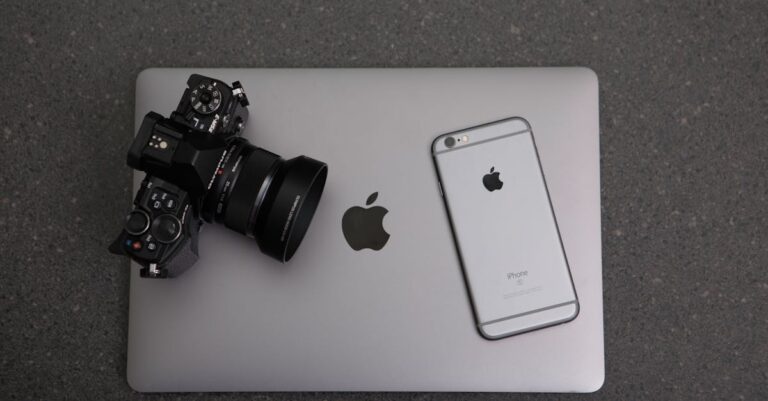Ever found yourself staring at a locked iPhone, feeling like it’s a fortress and you’re the hapless knight without a key? Don’t worry, you’re not alone. Many people have faced the frustration of being locked out of their devices, but there’s a silver lining. Unlocking your iPhone with a computer is not only possible, it can be surprisingly easy—and dare we say, a little fun.
Table of Contents
ToggleOverview of Unlocking iPhones
Unlocking iPhones involves bypassing restrictions set by Apple or carriers, allowing users to access their devices freely. Various methods exist for unlocking an iPhone, and using a computer represents one of the most effective options.
Many users encounter situations where they need to unlock their devices, such as forgotten passcodes or purchasing second-hand phones. Each method varies in complexity, and different tools can facilitate the process, offering a range of functionality.
Software solutions typically require installation on a computer and can include both free and paid versions. Compatibility with specific iPhone models and iOS versions plays a crucial role in determining the right tool to use. Some popular programs, like iTunes or third-party applications, offer built-in functionalities for unlocking.
Another aspect focuses on the connection between the iPhone and computer. Users must ensure proper USB connectivity for seamless communication between devices. When the connection is stable, the unlocking process often becomes faster and more efficient.
Options also extend to whether the device is factory reset or if data recovery is required. Various unlocking processes exist for different scenarios, ensuring users can find a suitable method for their needs. Effective unlocking not only restores access but can protect user data during the process.
Maintaining an up-to-date operating system for both the computer and iPhone is critical. Outdated software can lead to compatibility issues, potentially complicating the unlocking procedure. Following best practices ensures a smoother experience when attempting to unlock an iPhone with a computer.
Requirements for Unlocking
Unlocking an iPhone with a computer requires specific items for a smooth process. Ensuring availability of these items simplifies the unlocking steps.
Computer Specifications
A computer with sufficient processing power enhances unlocking efficiency. Brands like Mac or Windows systems both work well. Users must ensure they possess at least 4 GB of RAM alongside a dual-core processor. Operating systems should be updated to the latest versions for optimal performance. USB ports must be available and functional to facilitate a stable connection with the iPhone.
Software Needed
Specific software is essential for unlocking an iPhone effectively. Software options range from free tools to premium solutions. Users must download and install the software on their computers ahead of time. Compatibility with the iPhone model and iOS version is crucial. Many reputable programs offer step-by-step instructions, reducing the complexity of the unlocking process. Users can often rely on user reviews to identify the most effective software solutions.
Step-by-Step Guide on How to Unlock iPhone with a Computer
Unlocking an iPhone with a computer can be straightforward when following specific steps. The process varies depending on the tools used.
Using iTunes
iTunes serves as a reliable method to unlock an iPhone. Start by connecting the device to the computer using a USB cable. Then, launch iTunes and select the device. If the iPhone is recognized, navigate to the “Summary” section. Here, options like “Restore iPhone” appear. Confirm the selection, leading to complete device reset. This method removes passcodes but erases all content, requiring users to set up the device as new. Those with backups can restore data after unlocking.
Using Third-Party Software
Many third-party software options exist for unlocking iPhones efficiently. Begin by downloading a compatible tool onto the computer. After installation, connect the iPhone using a USB cable. Launch the software, which typically provides a user-friendly interface. Follow the on-screen instructions carefully. Some tools require entering the device information or supporting configurations. Upon completion, users gain access to an unlocked device without data loss. Ensure the chosen software is reputable to avoid potential risks.
Troubleshooting Common Issues
Unlocking an iPhone through a computer may present various challenges. Common issues include connection and software-related errors that can hinder the process.
Connection Problems
Connection problems often stem from faulty USB cables or ports. Users should attempt utilizing different USB cables to identify any malfunction. Checking USB ports on both the iPhone and computer is essential; dirt or damage can lead to unreliable connections. Restarting the computer or the iPhone might resolve temporary connectivity issues as well. Users should ensure that both devices are updated to the latest operating systems, as outdated versions can result in incompatibility.
Software Errors
Software errors can disrupt the unlocking process and stem from several factors. Incompatible software may cause unexpected failures, so selecting the right application compatible with the specific iPhone model is vital. Installation errors may occur if the software wasn’t downloaded correctly. Uninstalling and reinstalling the tool might rectify these issues. Following the user manual during the unlocking procedure ensures a smoother experience while reducing the risk of errors. Seeking support from the software’s support team can provide tailored solutions for complex problems.
Safety Considerations
Ensuring safety during the unlocking process is crucial. Users should always create backups of their data before attempting any unlocking methods. Doing so prevents potential data loss if issues arise during the procedure. Privacy also remains a top priority. Selecting reputable software mitigates the risk of malware or unauthorized access to sensitive information.
Staying aware of the legal implications of unlocking an iPhone helps users navigate the process correctly. Some jurisdictions have specific laws regulating this practice, especially in relation to carriers. Verifying compliance with local regulations guarantees adherence to legal guidelines. Additionally, monitoring the legitimacy of tools used during the unlocking process ensures a safer experience.
Using trusted USB cables and ports plays a significant role in minimizing connection issues. Faulty cables can lead to disruptions, complicating the unlocking task. Checking for damage beforehand saves time and frustration. It’s also advisable to use fully updated operating systems on both the computer and iPhone. Updates enhance compatibility and efficiency, streamlining the unlocking process.
Recognizing the possibility of software errors will prepare users for potential challenges. Sticking to instructions provided by trusted sources aids in reducing mishaps. Seeking professional help in case of persistent problems ensures that issues get resolved correctly. This approach prevents further complications, particularly when dealing with complex scenarios.
Unlocking an iPhone with a computer can be a straightforward process when equipped with the right tools and knowledge. By understanding the various methods available and following the necessary steps, users can regain access to their devices efficiently. It’s crucial to prioritize safety by backing up data and using reputable software to avoid potential risks.
Maintaining updated systems and ensuring a stable connection further enhances the unlocking experience. Whether tackling a forgotten passcode or a second-hand device, users can approach the unlocking process with confidence. With the right preparation and resources, unlocking an iPhone can be both manageable and rewarding.




